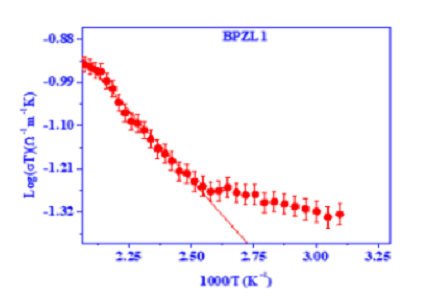


Indian Journal of Science and Technology
DOI: 10.17485/IJST/v14i46.1890
Year: 2021, Volume: 14, Issue: 46, Pages: 3416-3424
Original Article
Dawalappa B Husenkhan1, T Sankarappa2*, Amarkumar Malge1
1Research Scholar, Department of Physics, Gulbarga University, Karnataka, 585106, Kalaburagi, India
2Professor, Department of Physics, Gulbarga University, Karnataka, 585106, Kalaburagi,
India
*Corresponding Author
Email: [email protected]
Received Date:20 October 2021, Accepted Date:12 December 2021, Published Date:24 December 2021
Objectives: Investigation of electrical transport properties of glass system in the composition (P2O5)0:65x(B2O3)0:1 (ZnO)0:25 (Li2O) x where x=0.10, 0.15, 0.20, 0.25, 0.30, 0.35 and 0.40 and establish the conduction mechanisms. Methods: Glasses were synthesized using the standard melt quenching technique at 1473K. The samples were confirmed to be amorphous through XRD studies. An independent measurement of dc conductivity was carried out for temperature range 300-620K, by following two probe method. Findings: Conductivity of the present glasses is found to be of the order of 10-3 (Ω m)-1 which is higher than the reported values for lithium-ion solid-state electrolytes. Conductivity variation with temperature obeyed Mott’s Small Polaron Hopping at high temperatures and Variable Range Hopping at low temperatures. SPH model fits to the conductivity gave activation energies in the range 58-409 meV. VRH model fits gave density of states at Fermi level of the order of 1023 eV-1m-3. The nano-crystallite phases identified and determined size found to be in the range 5-37 nm and considered to be a glass-nanocomposites. Novelty/Applications: For the first time, zinc-lithium-borophosphate glasses are investigated for conduction mechanisms. Activation energy and density of states at the Fermi level are determined. At high temperature Mott’s SPH model and at low temperature Mott’s VRH model are found to be suitable to explain conductivity of these glasses.
Keywords: Boro Phosphate glasses; Small Polaron Hopping; activation energy; Variable Range Hopping; the density of states; conduction mechanism
© 2021 Husenkhan et al. This is an open-access article distributed under the terms of the Creative Commons Attribution License, which permits unrestricted use, distribution, and reproduction in any medium, provided the original author and source are credited.
Published By Indian Society for Education and Environment (iSee)
Subscribe now for latest articles and news.